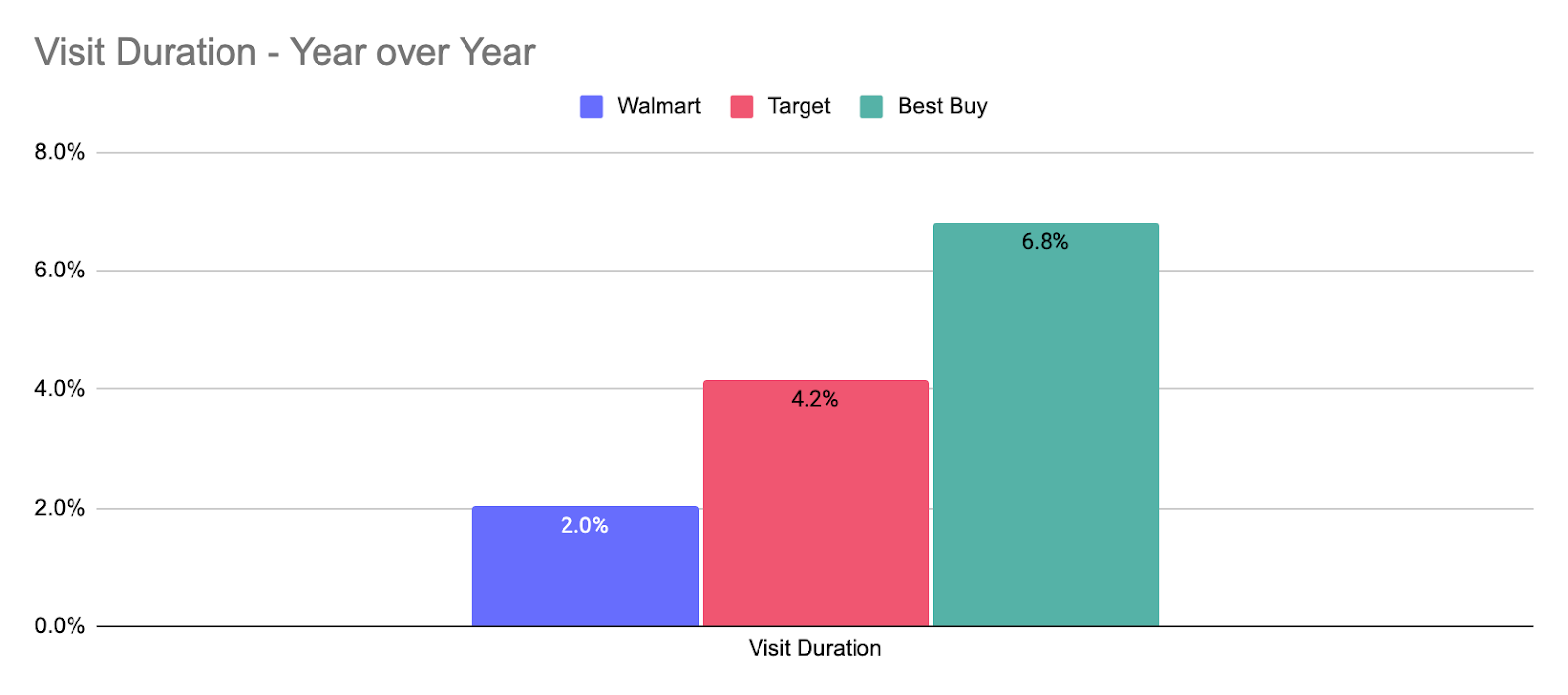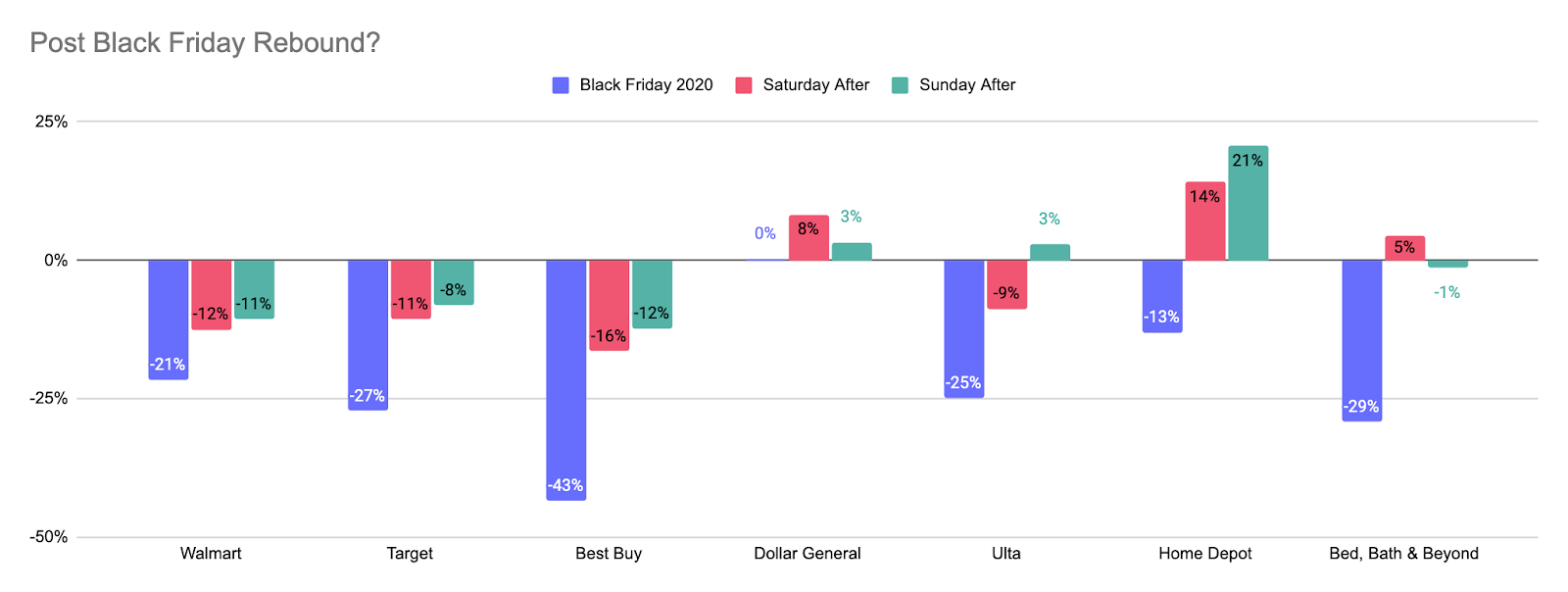
Black Friday 2020 was never going to reach the ‘normal’ peak that this retail extravaganza usually hits. But, the recent rise in COVID cases and added restrictions created an extra obstacle for some states to overcome.
So, what happened?
Black Friday Dips
Looking at six top retailers, with a focus on those who have done well in 2020, shows that impact. The six saw an average visit decline of 26.3% compared to Black Friday 2019. And this does not take into account the fact that many of these retailers were closed on Thanksgiving, meaning a complete loss of those visits.
Note – Home Depot was also closed on Thanksgiving. The ‘smaller’ decline is because they were also closed on Thanksgiving in 2019.

Expanding Our View
Yet, while this drop is significant, it requires a wider picture to show what truly happened this year. While brands like Walmart and Target saw significant Black Friday drops, the days leading up to Black Friday, and even the Saturday after, show a very different situation. Target, for example, saw visits up 2.8% and 5.3% the Saturday and Tuesday before, and while Black Friday visits were down 26.9%, the Saturday immediately after saw visits down just 10.0%. Walmart saw similarly strong numbers with daily visit declines in line with what had been seen in previous weeks and months. Best Buy also saw a similar pattern.

And 2020 has taught us that it isn’t just the number of visits, but the quality that matters. All three of these brands saw significant year-over-year increases in visit duration, a major indicator that while visits may have been down, basket size may have increased significantly. Looking at the four-day period from the Wednesday before Thanksgiving to the Thursday after, Walmart, Target and Best Buy saw visit duration increases of 2.0%, 4.2%, and 6.8% respectively. Critically, these were dates in 2019 where the visit duration was already larger than normal.

Black Friday Successes?
Taking this more expansive approach to analyzing Black Friday is equally critical when looking at other retailers. Ulta, for example, saw visits growth of 0.8%, 4.6%, and 11.4% on Saturday, Sunday, and Tuesday prior to Black Friday. And the Black Friday decline of 24.7% was followed by a Saturday where visits were only down 8.1%. The same held for Home Depot, who saw daily year-over-year visit increases of 33.0%, 21.2%, 18.8%, and 8.9% heading into Thanksgiving. But even after a 12.7% year-over-year visit decline on Black Friday, the brand quickly bounced back with visits up 15.0% the next day. Bed Bath & Beyond saw a similar trend seeing a 5.4% visit increase the Saturday after Black Friday even though they had experienced a 28.9% decline on the shopping day itself.

Outliers
But, not every brand exists within the gray area. Dollar General saw a huge week where visits were up as much as 21.0% the Saturday before Black Friday, but were still up 0.6% year over year on the day itself. At Home saw visits down just 0.9% year over year on Black Friday before seeing a 26.0% year-over-year increase the next day. Big Lots saw a similarly minor decline on Black Friday before seeing significant year-over-year growth on Saturday the 28th.

Post Black Friday Rebound
Critically, the holiday season is not over. All of the brands analyzed saw the largest visit gaps on Black Friday before watching those gaps shrink dramatically, if not turn into growth, on the Saturday and Sunday that followed. Many brands are showing the capacity needed to overcome Black Friday losses, and should this trend continue, offline retail performance in this holiday season may be much better than many expected.

Takeaways
2020 is a year unlike any other and we need to keep this in mind when analyzing retail. Yes, Black Friday visits were down significantly year over year, but that doesn’t mean the same thing for all retailers. Many, like Target, Walmart, and Best Buy, had already pushed to spread the season to other days. But, they also saw increases in visit duration indicating that we could be in store for growth that could offset if not overcome offline losses.
Additionally, several brands saw their Black Friday strength move to other days. Ulta saw a major surge pre-Thanksgiving, while Home Depot, Bed Bath & Beyond, and At Home all saw significant upticks in year-over-year traffic the day after Black Friday.
Does this mean offline retail is going to have its best season ever? Of course not. Does it mean we will need to take into account the full holiday season before jumping to any conclusions about overall success? Absolutely.
To learn more about the data behind this article and what Placer has to offer, visit https://www.placer.ai/.







Sign up to receive our stories in your inbox.
Data is changing the speed of business. Investors, Corporations, and Governments are buying new, differentiated data to gain visibility make better decisions. Don't fall behind. Let us help.













Sign up to receive our stories in your inbox.
Data is changing the speed of business. Investors, Corporations, and Governments are buying new, differentiated data to gain visibility make better decisions. Don't fall behind. Let us help.





